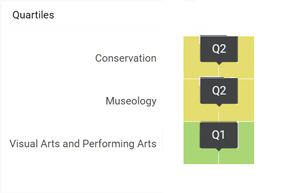Aesthetical presentation of a devotional artwork. Issues and possible virtual solutions
Abstract
In this contribution, the accent is focused on the complexities and possible solutions faced by a restorer during the phase of aesthetical presentation of devotional artworks. For this kind of artefacts is not often possible to apply the logic of conservative restauration (Zanardi 2009), which requires a minimum intervention. The devotional aspect is an added value protected by a number of symbolic codes (Argenton 2017) understood by the religious community, for which the artifact was intended. The work was also analysed through a series of interviews with various figures related to the devotional and liturgical artwork: the restorer, the art historian art and the religious community as user of the art work.
Downloads
References
ARGENTON, A. (2017). Arte e Cognizione. Introduzione alla psicologia dell’arte. https://www.docsity.com/it/libro-arte-e-cognizione-autore-argenton-a/4650674/. [Consult. 01/09/2019]
BARACCHINI, C. (1995). A cura di, Scultura lignea. Lucca 1200-1425. SPES, Firenze,
BENNARDI, D., FURFERI, R. (2007). Il Restauro Virtuale. Tra ideologia e Metodologia. EDIFIR, Florence, 14-15.
BIAGI MAINO, D., MAINO, G. (2017). Principi e applicazioni del restauro virtuale. EDIFIR, Florence.
BRANDI, C. (2010). Teoria del Restauro. Einaudi, Torino.
FORNI, V. (1998). ‘’Il problema critico delle integrazioni plastiche nella scultura lignea policroma’’, OPD Restauro, 10: 95-111.
MONTAGNOLO, I. (2018). Restauro e Arte Sacra. La presentazione estetica di un’opera devozionale: problematiche aperte e possibili soluzioni virtuali. Master Thesis. Università degli studi di Urbino Carlo Bo.
PERUSINI, G. (1989). Il restauro dei dipinti e delle sculture lignee, Del Bianco Editore, Udine.
TONINI, F. (2015). La scultura lignea tecniche e restauro. Manuale per allievi restauratori, Il Prato, Padova, 16-17.
ZANARDI, B. (2009). Il restauro. Giovanni Urbani e Cesare Brandi, due teorie a confronto, SKIRA, Milano.
- Copyright and intellectual property belongs to author. Author guarantees editing and publishing rights to Ge-Conservación Journal, under a Creative Commons Attribution License. This license allows others to share the work with authorship and the original source of publication acknowledgement.
- Articles can be used for scientific and educational purposes but never for commercial use, being sanctioned by law.
- The whole content of the article is author’s responsibility.
- Ge-Conservación Journal and authors may establish additional agreements for non-exclusive distribution of the work version published at the Journal (for example, on institutional repositories or on a book) with acknowledgment of the original publication on this Journal.
- Author is allowed and encouraged to disseminate his works electronically (for example, on institutional repositories or on its own website) after being published on Ge-Conservación Journal. This will contribute for fruitful interchanges as also for wider and earlier citations of the author’s works.
- Author’s personal data will only be used for the Journal purposes and will not be given to others.









